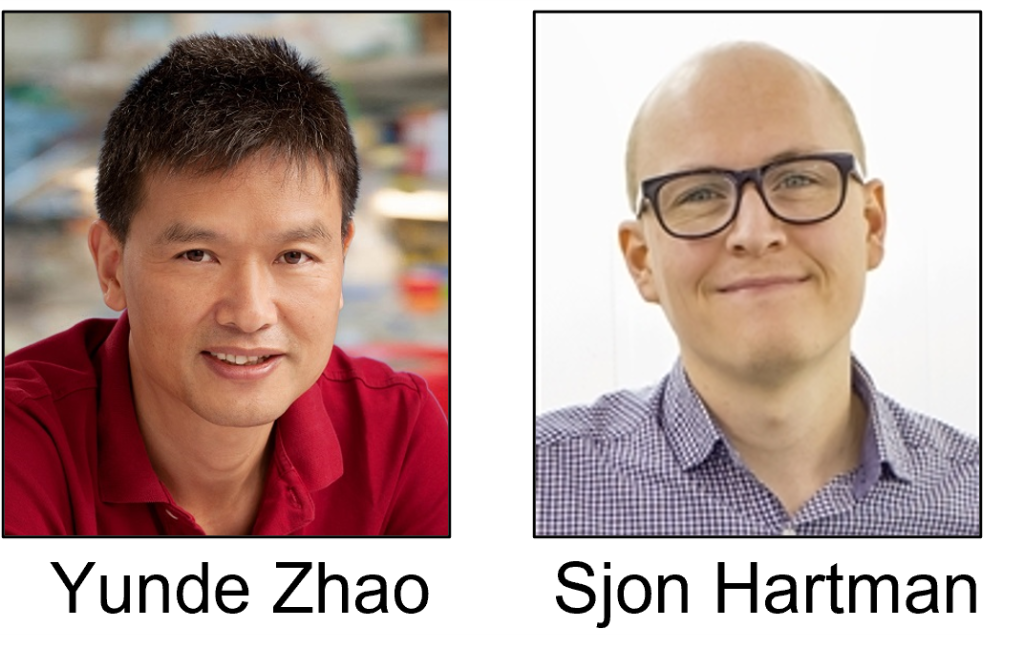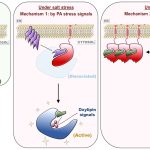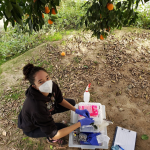Learning from the Experienced Editors: An interview of the Plant Physiology Editor-in-Chief Yunde Zhao, PhD
By Sjon Hartman, PhD
 Prof. Yunde Zhao completed his PhD in biochemistry at the University of Michigan under the supervision of Prof. Michael Marletta. He subsequently pursued a postdoc at Joanne Chory’s lab at the Salk Institute. In 2002, he started his lab at the University of California, San Diego, where he is until this day. Yunde’s lab studies the molecular mechanisms of auxin biosynthesis and signaling, and the development of gene editing technologies. Before becoming the Editor-in-Chief (EiC) of Plant Physiology at the start of this 2022, he was the EiC of Frontiers in Plant Science.
Prof. Yunde Zhao completed his PhD in biochemistry at the University of Michigan under the supervision of Prof. Michael Marletta. He subsequently pursued a postdoc at Joanne Chory’s lab at the Salk Institute. In 2002, he started his lab at the University of California, San Diego, where he is until this day. Yunde’s lab studies the molecular mechanisms of auxin biosynthesis and signaling, and the development of gene editing technologies. Before becoming the Editor-in-Chief (EiC) of Plant Physiology at the start of this 2022, he was the EiC of Frontiers in Plant Science.
Prof. Sjon Hartman completed his PhD in Plant Ecophysiology at Utrecht University (NL) in 2020. He did a brief postdoc in Plant Ecophysiology and the Gibbs lab at the University of Birmingham (UK) as a Rubicon fellow. At the start of 2022, Sjon started as a Junior Professor the University of Freiburg (DE). His group studies the molecular signaling events driving flooding stress tolerance and memory in plants. Sjon was a Plant Physiology Assistant Features Editor in 2020 and 2021.
Sjon: You initiated this program to allow Assistant Feature Editors (AFEs) to interview editors of Plant Physiology. Why?
Yunde: A main goal of the AFE program is to promote and assimilate the stories published in Plant Physiology. The other goal of this program is to train the next generation of editors and reviewers. In my view, the AFE program has another important function, which is to help AFEs advance their careers. Networking with prominent scientists in the field is important for career development. What is a better way to do it than having informal conversations between senior editors at Plant Physiology and the AFEs! These interviews also provide opportunities for Plant Physiology readers and authors to know more about our editors and the AFEs, and I think that this program is good for the plant biology community.
S: I love that. So, let’s find out then: who is the person behind the Editor-in-Chief Yunde Zhao?
Y: As you can judge from my accent, I did not grow up in the United States. I grew up in a small village in Hunan province, China. This area, at the time, was not well developed: no running water, no electricity, no library. I had to use a kerosene lamp to read a book. I was one of the lucky ones as I was able to go to high school and college in the city. In college, I became interested in science and considered a career in science. That’s the main reason I came to the US. As you know, US has been the center of scientific research for the past decades. I have stayed in the US ever since (1994).
S: What do you like to do when not doing science?
Y: I cook for my family. Cooking meals and having dinner with my children is an important way to bond and teach them to take responsibilities. Cooking is like doing an experiment. I like to experiment with new cooking ideas and learn from other cultures. In China, pretty much everything is stir-fried. In the US, I learned how to prepare a good steak, or fish dish. Another thing I like to do when I have free time is to watch movies with my kids. My favorite genre is crime movies, which are always very exciting and a little bit like science. You have to analyze the clues, who is the good guy, and who’s the bad guy. Nowadays, I rely on my younger daughter Michelle for movie recommendations. She is an avid moviegoer and maintains a blog about movies and writes about movies. Her recent recommendations were “Manhunter” and “Miami Vice,” both directed by Michael Mann.
S: How do you manage a healthy work/life balance?
Y: I think a healthy work/life balance is very important and it really takes efforts to achieve that. For me it is very important to spend time with my family. I cook every day and make sure that we have family dinner together. Kids grow up so fast, and I try my best to be part of their life. I plan my work schedule around my kids’ schedule. For instance, I sometimes would start an important experiment very early in the morning, maybe 5 am, go back home to have breakfast with my kids, take them to school, and go back to the lab to finish the experiment. My daughters are grown up now, so they don’t need me as much anymore and my schedule becomes more flexible. That is one of the reasons that I could take the EiC position. I think it is more effective if you have a routine and stable situation at home. Otherwise, it will be difficult to do well in science.
S: What made you decide to pursue a career in plant science?
Y: I did not start as a plant biologist. In college and in graduate school, my research was more orientated toward biochemistry and biomedical sciences. It was really after I received my PhD in biological chemistry at University of Michigan, I started to think about the long-term career goals. Biochemistry is a very mature field and biochemists typically try to understand the mechanistic basis of proteins and enzyme functions. I felt that genetics was a big missing piece of my academic training. I wanted to use genetics to identify key genes and to use my biochemical expertise to conduct detailed mechanistic studies of the genes. Plants are the best systems for genetic studies. I joined the Joanne Chory’s lab at the Salk Institute and learned how to work with Arabidopsis, a great genetic model. It is interesting that many prominent plant biologists including Joanne Chory were not initially trained in plant biology, but later switched to plant systems. My changing to plant biology worked out well for my career development. One advantage I have gained by changing fields is that I can combine biochemistry and genetics tools to address interesting biological questions.
S: You mentioned Joanne Chory, who is of course well known in the plant science field. Was she or any other mentors instrumental throughout your career and the way you do science?
Y: I am very lucky you know. My PhD advisor Michael Marletta, who is well known for his discoveries of nitric oxide synthesis and signaling in animals, taught me how to conduct detail-orientated mechanistic studies at the atomic level. Michael also enabled me to think freely and to use the best available technologies for my projects. My postdoc advisor, Joanne Chory, is a great mentor and has trained many plant biologists who are now leaders in their fields. One of the most important pieces of advice I received from Joanne was “genetics is the driving force of biology.” Not everyone would agree with that, but I took the advice to heart. For example, if your gene knockout does not have an obvious phenotype, I wouldn’t worry too much about that gene. A few years ago, we showed that knockouts of the AUXIN BINDING PROTEIN 1 did not lead to any phenotypes, prompting the field to re-evaluate the gene and the literature published in the past 4 decades. This is one example of the importance of genetics.
S: Auxin plays a big role in your research. Are there any specific “big” questions you still would like to answer within your career?
Y: There are still so many unanswered questions related to auxin. One thing that still puzzles me is why do the auxin mutants have different phenotypes? Mutants of other hormones—for instance, gibberellic acid biosynthesis mutants and signaling mutants—have very similar phenotypes. Both of them are dwarf. You can say the same for brassinolide biosynthesis and signaling mutants. We know that both jasmonic acid biosynthesis and receptor mutants are male sterile. Auxin mutants vary significantly in terms of developmental phenotypes. Why do the auxin transport mutants such as pins look very different from auxin biosynthetic yucca mutants? Another interesting observation is that every single flower in the yuc1 yuc4 double mutants is different in the type and number of floral organs. How can this happen? From a genetic point of view, the floral phenotype of yuc1 yuc4 does not make any sense. We have some hypotheses and hope to answer this question in the near future. In addition to our auxin research, we also try to develop new technologies that can help plant biologists. We recently developed the RUBY reporter gene. RUBY allows you to monitor gene expression and plant transformation without any chemical treatments or special equipment. More than 700 labs are already using it. Scientists around the world have sent me the beautiful pictures of their favorite plant species expression the RUBY reporter. RUBY has worked well in rice, wheat, goji berry, soybean, bamboo, and other plants. I am making a webpage dedicated to show RUBY expression in plants.
S: Yes. It’s an amazing tool and I’ve seen some of these pictures passing by on Twitter. Moving on to your role as EiC of Plant Physiology, very few people can say they have fulfilled this role. Why did you want to become EiC?
Y: The journal has a long history of publishing exciting and impactful discoveries. Plant Physiology has played a major role in my scientific career. It published several of my papers before I was tenured. Now I want to give back to the plant biology community and the journal. I understand that society journals in general are facing major challenges. Although Plant Physiology is doing relatively well compared to other society journals, and I want to ensure that Plant Physiology continues to serve as a vital platform for scientists to disseminate their research. One of the challenges is competition from other journals. Twenty years ago, there were essentially only a few plant biology journals, but now many journals publish plant research. Competition is beneficial to the scientific community and offers more options for scientists to publish their work. I will take initiatives to inform scientists the benefits of publishing in Plant Physiology. One of the initiatives is what we are doing now: the AEF-editor interview.
S: What do you see as current major problems in scientific publishing that you would like to address?
The publishing landscape is changing. There are so many open-access journals. Plant Physiology is still not a full open-access journal, but we offer an open-access option for authors. I think it is a matter of time before all journals, including Plant Physiology, are open access. An open-access journal has to publish certain number of papers each year to be financially sound, whereas subscription-based journals do not have that problem. Then the question is, how do you maintain quality and accessibility while facing the pressure to publish more papers? I think that we need to balance the financial need and the quality of the papers. I would like to point out that Plant Physiology offers many benefits that our competitors do not offer. Our editors are active and internationally recognized scientists. Our editors can understand the significance of research presented in a paper. Our AFEs write News and Views articles, which highlight the exciting research published in Plant Physiology. I will work with our editors, staff, and reviewers to ensure Plant Physiology remains affordable, accessible, and impactful.
S: One issue I personally see is the increased expectation for more and more data. Twenty years ago, you could get a high-profile paper by cloning 1 gene. Now having multiple layers of omics, several independent reporter and knockout lines, and 20 supplemental figures, it may still not be enough. Where does it end?
Y: I don’t like that. When I handle a manuscript as an editor, I tell the authors which experiments reviewers suggested should be included and which comments the authors can ignore. In my opinion, editors should carefully evaluate the manuscripts and should not completely depend on reviewers. Again, Plant Physiology is well-equipped to handle manuscripts fairly because our editors are active scientists. I am still doing bench work. An active scientist is in a better position to judge the quality, significance of the results, and improvements needed.
As an author, I typically have 4 to 5 main figures and very few supplemental files for an initial submission. Sometimes people include a lot of data in a manuscript and the main message of the paper gets lost. I believe if a paper presents an interesting finding and the conclusions are justified based on the results, the paper should be accepted. Of course, novelty and interesting findings are very subjective. I mentioned our RUBY reporter previously and it has been downloaded 25,000 times since its publication in September 2020. Unfortunately, I had a very difficult time publishing it because editors and reviewers commented that the work lacked novelty, which was false judging from the overwhelming enthusiasm from the plant biology community. My experience tells you that even a beautiful piece of work can be easily ignored by editors and reviewers. Now, when I present seminars, I am very proud of showing the rejection letters of the RUBY work.
As an editor, we should refrain from the temptation to demand more and more from authors. Our mission at Plant Physiology is to help scientists disseminate their discoveries, not to make a publishable story perfect. I think that it’s good that scientific publishing is not monopolized by only several publishers, so that there are options for authors to share their findings.
S: Thank you Yunde, is there anything else you would like to say?
Y: I want to say something to the young scientists. It can be challenging to work hard, spend days and nights in the lab, and in the end only have disappointing results. Even if you have made an exciting discovery, the publishing experience can be very frustrating. Plant Physiology can help you! Our editors and I will ensure a rigorous and fair review of your work.
I also would like to encourage young scientists to share your excitement, passion, and motivation with your colleagues. Go have a coffee with friends and labmates. Social gathering is not a waste of time, rather it often stimulates great ideas. I was having a coffee with a friend who is not a plant biologist a few years ago. That conversation led to experiments that eventually uncovered a mechanism of auxin biosynthesis.
S: That’s great and I agree, I live by coffee breaks and social chats. Actually, when I was a PhD student in Utrecht we had daily coffee breaks at 10:30 sharp. My supervisor at the time, Rens Voesenek, was the one who made sure we kept doing this as he understood the value of this social interaction. From this lab, 2 PIs are current Plant Phys editors and the group also delivered 5 AFEs so far, so maybe having coffee together is the golden secret for ending up at Plant Phys. How to test his hypothesis? I’ll make sure to keep this tradition in my new lab.
Y: Awesome. Plant Physiology needs the support from all plant biologists. Working together as authors, reviewers, and editors, we can make Plant Physiology one of the best platforms for scientists to share their work and to advance their careers.
Read more interviews of Plant Physiology editors here.



